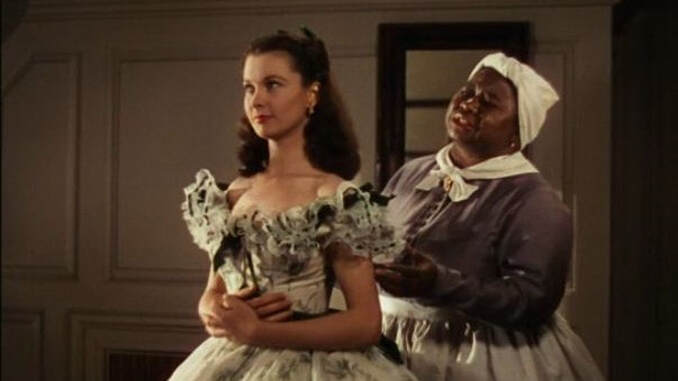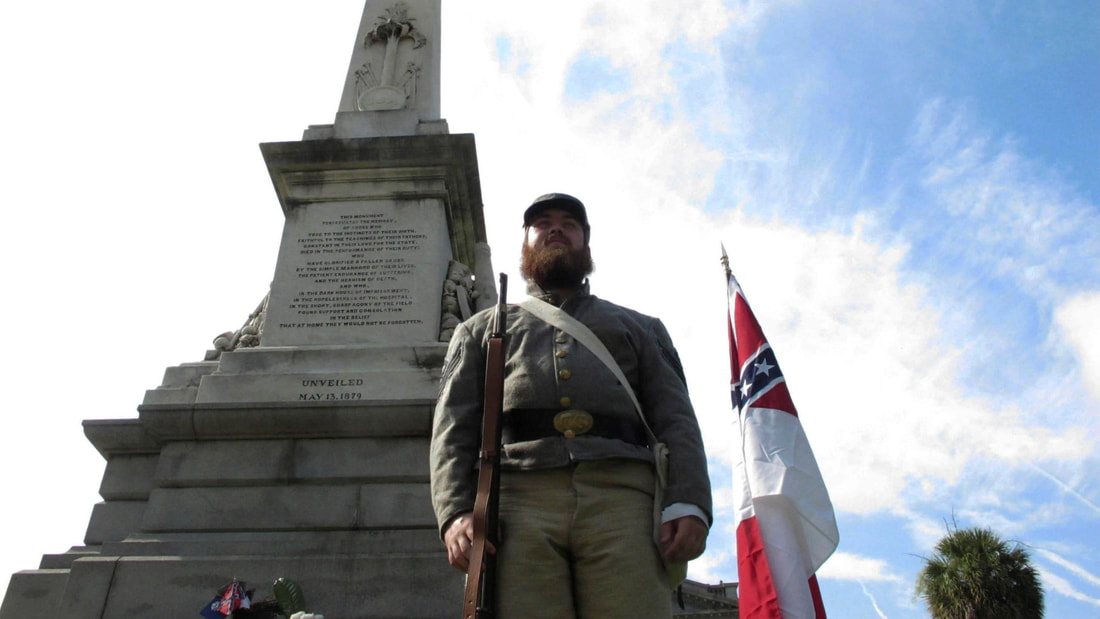|
Hollywood films set in the South adhered closely to the cultural customs existing during the time period wherein the action takes place. But activists insist that even though a film portrays an earlier generation, it must conform to the standards of the current generation. Consequently, films set in the 19th century must either conform to 21st century standards or contain a waiver disclosing their deviance from those standards. An unusual case is ‘The Birth of a Nation.’ the acclaimed D.W. Griffith film. The film uses a Southern viewpoint to portray the effects of the War Between the States and Reconstruction on a Northern family and a Southern family. Griffith was familiar with those effects, being the son of a Confederate colonel, born shortly after the War ended. The settings of his film accord with conditions of his time, unhindered by sensitivities of future generations. BOAN was released as a silent film in 1915 and sound was added in 1930. Griffith was captivated by the emerging trend of filming pictures in motion. The filming techniques he concocted were crucial to the development of motion pictures and he is often credited with creating the Hollywood film industry. In recognition of his technical contributions, the Motion Picture Academy created the D.W. Griffith Award, to honor directors with outstanding lifetime achievements. The NAACP had existed for only six years when BOAN was first screened but the fledgling organization tried to have the film banned or at least have certain scenes deleted. The NAACP’s efforts failed but it never surrendered its opposition to Griffith or his film. Years later, in 1999, the Director’s Guild of the Motion Picture Academy capitulated to NAACP demands, and removed Griffith’s name from the prestigious D.W. Griffith Award. It is now called the ‘Lifetime Achievement Award.’ So, the man whose innovated filming techniques were essential to the film industry’s creation can no longer be mentioned during Hollywood’s annual ceremony. Another equally renowned and maligned Southern film is the 1939 version of Margaret Mitchell’s novel ‘Gone With The Wind.’ For decades this film has continuously filled theaters and has been widely praised by audiences. Set in the antebellum South, GWTW is the story of vain, self-centered Scarlett O’Hara, probably the best known female protagonist in literature and movies. GWTW begins with Scarlett as a 16 year old flighty Southern Belle and , although she survived hardships after the War and Reconstruction decimated her fashionable lifestyle, the story ends with her as a skittish 28 year old still lacking mature judgment. (Some of today’s women characterize Scarlett as an early feminist, but that’s too much of a stretch.) GWTW has been screened innumerable times in the eight decades since its release. Adjusted for inflation, GWTW is probably the most financially profitable film, estimated earnings exceeding $2 billion. It won eight Academy Awards including best film and best actress. Hattie McDaniel won best supporting actress, the first Black to win an Academy Award. Today’s activists take issue with the film’s depiction of amiable relations between the O’Hara family and its slaves. But GWTW portrays only house slaves who were treated better than field slaves. Activists also object to the house slave Mammy being allowed to scold and criticize Scarlett and other members of the O’Hara family. Although elites prefer that GWTW not be shown, there is a reluctance to ban such a well crafted film. However, they insist that each screening be preceded with a brief statement putting the film into perspective – a warning about its implied racism. A television host contextualized GWTW as follows: "The film presents the antebellum South as a world of grace and beauty, without acknowledging the brutalities of the system of chattel slavery, upon which this world is based." GWTW avoided being banned and was only contextualized but Disney’s 1946 ‘Song of the South’ was actually banned. SOTS is faulted for its “outdated cultural depictions.” That criticism can also apply to Disney films such as ‘Snow White and The Seven Dwarves’ and ‘Sleeping Beauty.’ We can assume they weren’t banned because they weren’t associated with the racist South. Disney insists that SOTS wasn’t banned but it will not allow the film to be shown. Disney also rejected the screening of a contextualized versions of the film. The film was deleted from Disney’s streaming service and recordings of the award winning song ‘Zip-a-Dee-Doo-Dah’ were removed from various Walt Disney World sites. The NAACP maintains that SOTS “...gives the impression of an idyllic master-slave relationship, which is a distortion of the facts.” But James Baskett, the actor who played Uncle Remus in the film, took a different view: “I believe that certain groups are doing my race more harm in seeking to create dissension than can ever possibly come out of the Song of the South.” Baskett won an honorary Academy Award for his performance. Leftist media considers the antebellum South a bygone and bigoted epoch, undeserving of future portrayals in movies. However, the contemporary South is a convenient movie device for exploiting racial injustice. This is the case with the1967 Hollywood film ‘In the Heat of the Night’, one of many “liberal message movies.” The plot of this movie is fairly typical of how the South is stereotyped in films. While waiting for a train in a small racist Mississippi town, a Black Philadelphia detective is arrested by a bigoted local sheriff who refers to him as “boy”. In this caricature of a small Southern town, uninformed inhabitants distrust all strangers especially Blacks and Northerners. Local law enforcement detains the Black detective but without evidence has to release him. The police chief learns of the detective’s crime solving abilities, puts aside his prejudice, and requests the detective’s help in apprehending the real murderer. Locals are impressed when the Black detective’s skillful investigation expeditiously uncovers the real murderer. In a cliched Hollywood ending, the White sheriff abandons his racist attitudes and befriends the Black detective. Many of the locals also modify their racist opinions of Blacks. The film won five Academy Awards including best film and best actor. Some questioned its selection as best film as its competition included ‘Bonnie and Clyde’, ‘The Graduate” and ‘Guess Who’s Coming to Dinner’ . But this film was considered to be more ‘socially relevant’ - more important than artistic merit. Regardless of its quality, its political message has made it a television favorite. It was even made into a televised series as well as a play. Finally, (I’m not making this up) a study guide of the film was created for students to learn about segregation and racism in the 1960s South. Hollywood no longer portrays the South favorably. So, if you can locate DVDs of those early, fair and equitable, Southern films, you should strongly consider purchasing them. As the ethnicity and gender of actors and actresses has become more important than their acting skills, today’s Hollywood rarely produces watchable films and its survival is in doubt.
0 Comments
We live in a surreal generation, where boys think they can become girls and girls think they can become boys. This generation has been deluged with the ‘equality’ gospel: everyone is equal and everyone can achieve at the same level. But equality is idealistic, not realistic. And our history is replete with failures as well as successes. We’ve had both heroes and commoners. Among the heroes of the past, my most admired are George Washington, Thomas Jefferson, and Robert E. Lee. Social activists often denounce this famous threesome as White supremacists, even “White Christian supremacists.” The anti-White slur has become pervasive while the anti-Christian slander is of recent origin, possibly being tested for its effectiveness. Monuments honoring these luminaries are being removed or contextualized to minimize their historical status. The nation is now enduring what Southerners endured with the maligning of Southern traditions Monument removals are sometimes classified as an act of social justice. Activists think they are capable of passing judgment on America and its past although their understanding of our history is limited. Their versions of history are sometimes related using ‘storytelling’, an archetypal narrative that doesn’t involve verified facts. ‘Storytelling’ is often simplistic but it bolsters social justice theories. Politicians also tend to view history simplistically, often as a collection of heroes and villains. Consider President Biden’s voting rights speech to students at Atlanta University, a cluster of Black colleges. Biden asked his audience: “Do you want to be on the side of Abraham Lincoln or Jefferson Davis ?” The way history is currently taught, these students would certainly be familiar with slavery and racism but might not recognize Jefferson Davis. Also, they assuredly have heard the “storybook” version of Lincoln freeing the slaves. But his Emancipation Proclamation freed no slaves. Slaves weren’t legally freed until the ratification of the 13th Amendment, almost nine months after Lincoln’s death. If Lincoln’s opinion of Blacks were judged by today’s standards, he would be considered a racist. Lincoln’s presidency has been significantly embroidered, giving him credit for freeing the slaves and saving the Union. As a result of these hyperbolic interpretations, Lincoln has been ranked as our greatest presidents, with George Washington following in second place. But a factual, unemotional assessment of history would make George Washington our best president. Placating minorities has not only involved defiling famous monuments but also modifying our traditions. Names of White heroes have been removed from our national holidays. Other than Christmas, Martin Luther King Jr Day is now the only national holiday honoring a person. Abraham Lincoln’s Birthday and George Washington’s Birthday were combined into the benign President’s Day. And Columbus Day became Indigenous Peoples Day. President Biden recently added Juneteenth as a national holiday. But what happened on that date that was special enough to justify the creation of a national holiday ? On June 19th 1865, a Union officer informed slaves in Galveston, Texas that they had been freed. Only in this politicized era could such an unpretentious event become a national holiday. Juneteenth is the first national holiday created since Martin Luther King Jr. Day was added. As we can only have a limited number of national holidays, many prestigious heroes were honored with monuments and other forms of esteem. This group of luminaries includes Robert E. Lee. Although he led Southern forces in the War Between the States, Lee later attained national acclaim. General Lee is admired not only for who he was but for what he symbolizes; a loyal citizen and a devout Christian. During Thomas Jefferson’s first term as president, a political enemy implied an affair between Jefferson and one of his female slaves. This affair was based on scuttlebutt circulating in Jefferson’s Virginia county while he was still a fairly young widower. The story was short-lived and soon fell into obscurity where it remained for over a century. It was recently revived and accepted as credible by the Thomas Jefferson Foundation. But the Thomas Jefferson Heritage Society reexamined the accumulated evidence and refuted the claim. George Washington, Thomas Jefferson, and Robert E. Lee should be our nation’s most respected figures. But social activists associate them with the institution of slavery and equate their monuments and memorials with White supremacy. So those of us who hold these men in esteem must strive to protect their reputations as well as their monuments and memorials. |
AuthorGail Jarvis is a Georgia-based free-lance writer. He attended the University of Alabama and has a degree from Birmingham Southern College. His writing is influenced by years of witnessing how versions of news and history were distorted for political reasons. Mr. Jarvis is a member of the Society of Independent Southern Historians and his articles have appeared on various websites, magazines, and publications for several organizations. He lives in Coastal Georgia. Archives
June 2023
|


